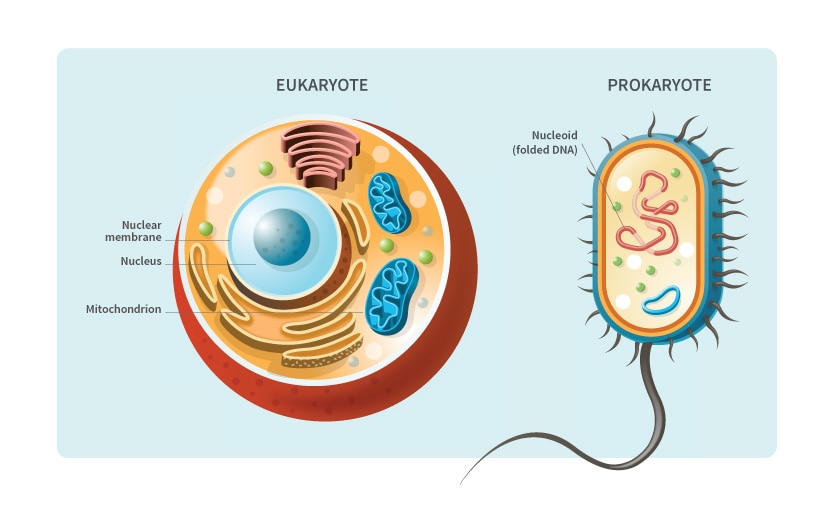Where is DNA found in a cell?
From the single cell of bacteria to the trillions in humans, cells, often called the “building blocks of life,” make up all living things. Each of these cells is a discrete structure surrounded by a cell membrane and filled with a thick solution called cytoplasm. In human cells, most DNA is found in a compartment within the cell called a nucleus. It is known as nuclear DNA.

In addition to nuclear DNA, a small amount of DNA in humans and other complex organisms can also be found in the mitochondria. This DNA is called mitochondrial DNA (mtDNA). Most plants have a set of DNA contained within their chloroplasts called chloroplast DNA (cpDNA). The complete set of DNA is known as the genome.
Where Is DNA Located in a Eukaryotic Cell?
Cells can be broadly grouped into two different types: cells found in prokaryotes (prokaryotic cells) and cells found in eukaryotes (eukaryotic cells). Prokaryotes tend to be single-celled and lack a membrane-bound nucleus and other membrane-surrounded structures called organelles. They include two distinct groups: bacteria and archaea.
Eukaryotes can be single-celled or multicellular. Unlike prokaryotic cells, eukaryotic cells have a nucleus and other organelles. Eukaryotes encompass a wide range of organisms, from fungi to plants and animals.
In prokaryotic cells, the DNA is mostly located in a central part of the cell called the nucleoid, which is not enclosed in a nuclear membrane. Most of the genetic material in most prokaryotes takes the form of a single circular DNA molecule, or chromosome.
In addition, many prokaryotes also contain small circular DNA molecules called plasmids. These are distinct from their chromosomal DNA and in specific environments can provide certain advantages such as resistance to antibiotics.
In eukaryotic cells, most DNA is located in the cell nucleus (though some DNA is also contained in other organelles, such as in the mitochondria and the chloroplast in plants). Nuclear DNA is organized into linear molecules called chromosomes.
The size and number of chromosomes varies significantly between species. The fruit fly (Drosophila) has 4 chromosomes, for example, whereas a toad (Xenopus laevis) has 18 chromosomes. In humans, most cells typically have 46 chromosomes, or 23 pairs. Exceptions to this include mature red blood cells which contain no DNA and sperm and egg cells which have 23 unpaired chromosomes.
Chromosomes are made of a single molecule of DNA wrapped around a small, spool-like protein called a histone. The wrapping of DNA around a histone is important, as otherwise most DNA molecules would not fit inside of cells.
In humans, for example, the total length of DNA in one cell, if you were to unwind and stretch out the DNA molecules end-to-end, would be over six feet long (or about two meters). But that amount of DNA must fit into the cell’s nucleus, which only has a diameter of five to ten μm. This means that fitting all the DNA in one human cell’s nucleus is the equivalent to packing 24 miles (about 40 km) of very thin thread into a tennis ball!
What Is the Function of DNA in a Cell?
The key function of DNA in a cell is to store the genetic information that allows an organism to develop, function, and reproduce. The information encoded in DNA can be passed on from one generation to the next and acts as a biological instruction manual that makes each organism unique.
To follow the instructions in DNA, a cell must first copy a gene into a form of RNA called messenger RNA (mRNA). This process is known as transcription. In many cases the information contained within DNA needs to be translated into a protein in order for the instructions to be carried out, as proteins take care of most of the work in cells, performing a wide variety of critical functions.